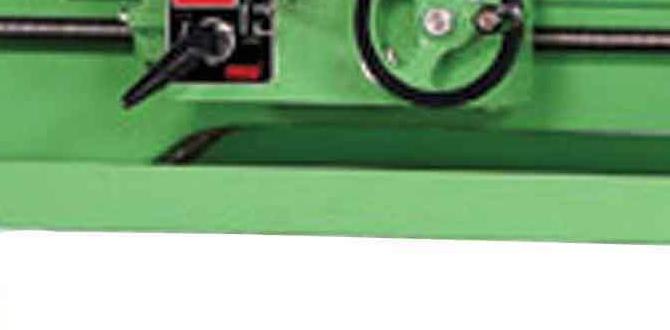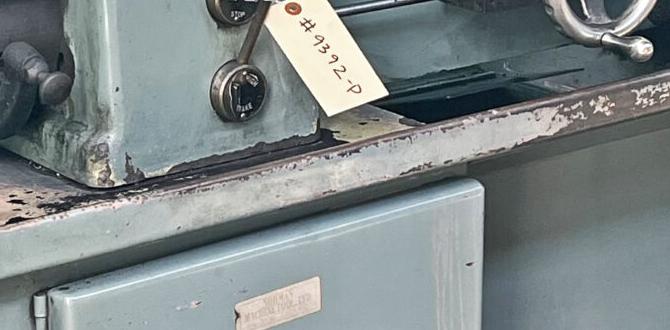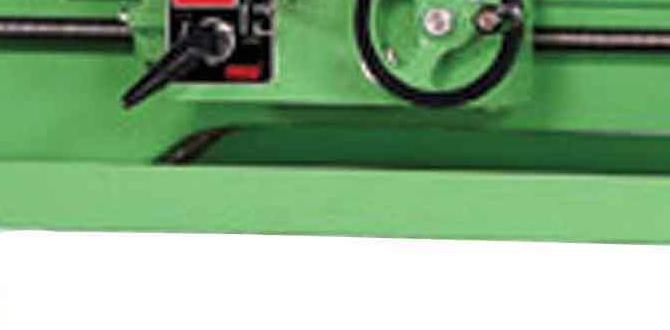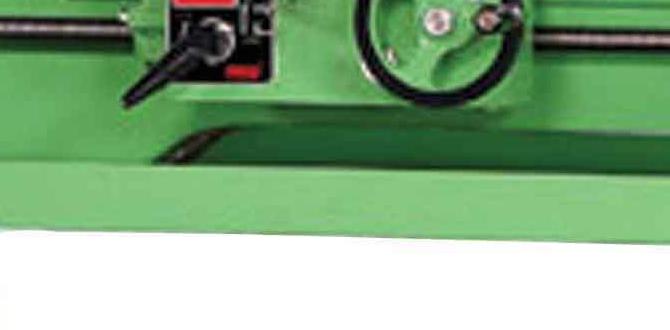Quick Summary: Unlock high Material Removal Rate (MRR) in D2 steel with a 3/16″ carbide end mill. This guide shows beginners how to select, set up, and safely use this tool for efficient machining of D2 steel.
Mastering D2 Steel: Your Guide to the 3/16″ Carbide End Mill for High MRR
Working with tough materials like D2 steel can be a headache for beginners. It’s hard, it chips easily if you’re not careful, and getting it to machine smoothly feels like a constant battle. You want to get things done, but your tools seem to be fighting back, slowing you down and risking damage. It’s easy to feel frustrated when you’re just trying to learn and create. But what if I told you there’s a simple, effective way to tackle D2 steel with confidence? In this guide, we’ll break down how using the right 3/16″ carbide end mill can dramatically boost your machining speed and efficiency, making D2 steel much more manageable. Get ready to transform your cuts and achieve impressive results!
Why D2 Steel is a Tough Nut to Crack
D2 tool steel is famous for its high hardness, excellent wear resistance, and good toughness, making it a popular choice for tools, dies, and knives. However, these same qualities make it notoriously difficult to machine. It’s a high-alloy steel, which means it contains a significant amount of alloying elements like chromium and molybdenum. These elements contribute to its hardness but also make it prone to work hardening – a process where the material becomes even harder the more you try to cut it. This can lead to rapid tool wear, poor surface finish, and slow machining speeds if you don’t have the right approach.
Introducing the 3/16″ Carbide End Mill for D2 Steel
When machining D2 steel, tool selection is crucial. For smaller features and detailed work, a 3/16″ carbide end mill is often the go-to. But not just any end mill will do. We’re looking for specific characteristics that make it suitable for this challenging material. A common and effective choice is a 3/16″ diameter carbide end mill with a 1/2″ shank, often in a stub length configuration, designed for tool steels. Let’s break down why this specific tool is so effective at achieving high Material Removal Rate (MRR) in D2.
What is Material Removal Rate (MRR)?
Before we dive deeper, let’s quickly define MRR. Material Removal Rate is a measure of how much material your machining process can remove per unit of time. A higher MRR means you’re cutting faster and more efficiently. For D2 steel, achieving a good MRR is key to making your work practical and economical. It’s calculated using a simple formula:
MRR = (Cutting Speed × Depth of Cut × Feed Rate) / (Tool Diameter × Number of Flutes)
While this formula looks technical, it highlights the factors we can control: primarily, the chip load (which is related to feed rate and depth of cut) and the cutting speed. A well-chosen end mill, like our 3/16″ carbide tool, allows us to push these parameters safely.
Why Carbide is King for D2
When it comes to cutting hard materials like D2 steel, carbide tooling is almost always superior to High-Speed Steel (HSS). Here’s why:
- Hardness: Carbide maintains its hardness at much higher temperatures than HSS, which is essential when cutting tough steels that generate significant heat.
- Heat Resistance: It can withstand the extreme heat produced during D2 machining without losing its cutting edge.
- Wear Resistance: Carbide is significantly more wear-resistant, meaning it will last longer and maintain its sharpness, leading to a better finish and more consistent cuts.
- Rigidity: Carbide is a denser, more rigid material, which helps minimize tool deflection, especially important for smaller diameter tools like our 3/16″ end mill.
The Importance of 3/16″ Diameter
A 3/16″ diameter end mill is excellent for achieving detail and working in tighter spaces often found when machining dies, molds, or intricate parts from D2. While larger end mills might remove material faster, a 3/16″ tool offers the precision needed for many D2 applications, and with the right setup, can still deliver impressive MRR.
What about 1/2″ Shank and Stub Length?
The 1/2″ shank provides a good balance of rigidity and clearance in many milling machine setups. Tooling with a larger shank diameter is generally more rigid. A “stub length” refers to an end mill that is shorter than a standard length end mill. This shorter flute length and overall tool length contribute to:
- Increased Rigidity: Less tool overhang means less chance of vibration and deflection, leading to more accurate cuts and a better surface finish.
- Reduced Chatter: Chatter is that annoying vibration that ruins your finish. A shorter, more rigid tool helps prevent it.
- Higher Feed Rates: With less deflection and chatter, you can often push the feed rate higher, directly increasing your MRR.
Tooling for Tool Steel: What to Look For
When selecting a 3/16″ carbide end mill specifically for D2 steel, keep these features in mind:
| Feature | Why it Matters for D2 |
|---|---|
| Number of Flutes | For D2, 2-flute or 3-flute end mills are generally preferred. Fewer flutes allow for better chip evacuation, which is critical in tough, gummy materials like D2 to prevent re-cutting chips, overheating, and tool breakage. 4-flute tools can be used for finishing but can struggle with chip clearing in this material. |
| Coating | A good coating can dramatically improve performance. TiAlN (Titanium Aluminum Nitride) or AlTiN (Aluminum Titanium Nitride) coatings are excellent choices for machining steels. They add hardness, lubricity, and thermal resistance, helping the tool cut cooler and last longer. |
| Edge Preparation | Look for end mills with a slightly honed or micro-polished edge. This “pre-sharpening” helps reduce the tendency of gummy materials like D2 to stick to the cutting edge and also promotes smoother cutting. Avoid tools with a delicate, ultra-sharp edge that might be prone to chipping. A robust cutting edge is key here. |
| Helix Angle | A standard helix angle of 30 degrees is common. For tougher materials, sometimes a lower helix angle (around 20 degrees) can provide a stronger cutting edge, but a standard angle is usually a good starting point for general-purpose D2 machining. Some specialized “high performance” end mills for difficult materials might have variable helix or specialized flute geometries. |
Setting Up for Success: Machine and Tooling Considerations
It’s not just about the tool; your machine setup plays a huge role in achieving good MRR with D2 steel using a 3/16″ end mill.
Machine Rigidity is Key
A solid, rigid milling machine is paramount when working with tough materials. If your machine has play in the ways, a loose spindle, or a worn-out Z-axis, you’ll struggle to get clean cuts. Vibrations will be amplified, leading to poor surface finish and increased tool wear. For precise D2 work, a well-maintained milling machine that can handle the forces involved is non-negotiable.
Workholding: Secure That Part!
Absolutely ensure your workpiece is securely held. Any movement or vibration in the workholding setup will translate directly into poor cut quality and can easily lead to tool breakage. Use clamps, vises, or fixtures that provide firm, stable support. Keep your workholding as close and as rigid as possible to the cutting operation.
Coolant and Lubrication: Your Best Friend
Machining D2 steel generates a lot of heat. Without proper cooling, your end mill will overheat, lose its hardness, and fail prematurely. A good cutting fluid or coolant is essential for:
- Cooling the Tool and Workpiece: Preventing excessive heat buildup.
- Lubricating the Cut: Reducing friction and wear on the cutting edge.
- Flushing Chips Away: Helping to keep the flutes clear for better chip evacuation.
For D2, a flood coolant system is ideal. If you’re using a smaller home workshop setup, a good quality cutting fluid applied with a mister or through a nozzle directly at the cutting zone is a must. Look for fluids specifically designed for machining steel.
According to the Machinery Forum community, a common recommendation for tough steels like D2 is to use a synthetic or semi-synthetic coolant, which offers good cooling and lubricity without the potential mess of some straight oils. Always refer to manufacturer recommendations for your specific cutting fluid and machining conditions.
Balancing Machining Parameters
Getting the right balance of spindle speed (RPM) and feed rate is where you achieve high MRR without damaging your tool or workpiece. This is often the trickiest part for beginners.
Spindle Speed (RPM)
The ideal RPM depends on the carbide end mill’s diameter, the material being cut, and its coating. For a 3/16″ carbide end mill in D2 steel, you’ll typically be running at relatively low speeds compared to softer materials. A good starting point might be anywhere from 200 to 800 RPM. Always consult the end mill manufacturer’s recommendations, as they often provide starting speed and feed charts for various materials.
Feed Rate (IPM or mm/min)
The feed rate determines how fast the tool moves through the material. This is directly tied to the chip load – the thickness of the chip being produced by each cutting edge. For D2 with a 3/16″ end mill:
- Chip Load: Aim for a chip load that is appropriate for the tool and material. For a 3/16″ carbide end mill in D2, a chip load might range from 0.001″ to 0.003″ per flute.
- Calculating Feed Rate: Feed Rate (IPM) = Spindle Speed (RPM) × Number of Flutes × Chip Load (inches/flute)
Example: For a 2-flute end mill running at 400 RPM with a chip load of 0.002″ per flute:
Feed Rate = 400 × 2 × 0.002 = 1.6 IPM
This sounds very slow, but for D2 steel, this controlled feed is necessary. Pushing too fast will overload the tool and lead to breakage or work hardening.
Depth of Cut (DOC) and Width of Cut (WOC)
For high MRR, you want to take as deep and wide a cut as your machine and tool rigidity will allow without causing excessive vibration or chatter.
- Depth of Cut (DOC): For roughing cuts in D2 with a 3/16″ end mill, you might aim for a DOC of 0.050″ to 0.100″ or even more, depending on your machine’s Z-axis power and rigidity. It’s crucial to avoid taking very shallow depths of cut (like 0.010″) in tough steels, as this can lead to work hardening and rapid edge wear. Aim for a DOC that ensures the tool is “biting” into the material properly.
- Width of Cut (WOC): When slotting (cutting a full-width slot), the WOC is equal to the end mill diameter (0.1875″). For profiling or pocketing, you can take a WOC of 50% of the tool diameter (approx. 0.094″) or more for roughing. For best results and to avoid excessive side loading on the tool, consider trochoidal milling (also known as high-efficiency machining or HSM) strategies if your CAM software supports it. This involves cutting in a circular path with a small WOC and high feed rate, which keeps chip load consistent and greatly reduces heat buildup and tool stress.
Step-by-Step Guide: Machining D2 Steel with Your 3/16″ End Mill
Let’s walk through the process of using your 3/16″ carbide end mill to machine D2 steel.
Step 1: Gather Your Tools and Materials
Before you begin, ensure you have:
- A rigid milling machine in good working order.
- A high-quality 3/16″ carbide end mill (e.g., 2-flute, coated, stub length).
- A secure workholding setup (vise, clamps).
- Appropriate cutting fluid or coolant and delivery system.
- Safety glasses and other necessary personal protective equipment (PPE).
- A tool holder for your end mill.
- A means to measure and set your tool height (height gauge, edge finder, or probe).
- Your D2 steel workpiece.
Step 2: Load the End Mill
Ensure your milling machine spindle is clean. Insert the 3/16″ end mill into a suitable end mill holder or collet chuck. Tighten it securely, ensuring it’s centered. A good quality collet chuck will provide the best runout and rigidity.
Step 3: Secure the Workpiece
Place your D2 steel workpiece in the vise or fixture. Ensure it is seated firmly. Use parallel stock if needed to get the workpiece level in the vise jaws. Tighten the vise securely. Double-check that the workpiece will not move during machining.
Step 4: Set Your Zero and Tool Height
Use your preferred method to set your X, Y, and Z machine zero points. For Z zero, you’ll typically touch off on the top surface of your workpiece. Ensure the quill is locked once you’ve set the Z-zero to prevent it from moving unintentionally.
Step 5: Program or Manually Set Your Cutting Parameters
Based on the manufacturer’s recommendations and the guidelines above, set your spindle speed (RPM) and feed rate (IPM). For beginners, it’s wise to start conservatively (e.g., lower end of the RPM range, appropriate chip load) and increase gradually if conditions allow.
Example Parameters (Starting Point):
- Tool: 3/16″ 2-flute carbide end mill, TiAlN coated, stub length
- Material: D2 Steel (Annealed)
- Spindle Speed: 400 RPM
- Feed Rate: 1.6 IPM (0.002″ chip load)
- Depth of Cut (DOC): 0.075″
- Width of Cut (WOC) for profiling: 0.100″
- Coolant: Flood coolant ON
Step 6: Perform a Dry Run (Optional But Recommended)
Before engaging the metal, run the program or move the axes at your programmed speeds and feeds with the spindle turned off. This helps ensure your toolpath and clearances are correct and that nothing unexpected will happen.
Step 7: Engage the Material
Turn on your spindle and coolant. Slowly advance the tool into the workpiece at your programmed feed rate. Listen to the sound of the cut. You’re looking for a consistent, crisp cutting sound, not a loud screeching or chattering. The chips should be a nice, manageable size and color (avoiding deep blue, which indicates overheating).
Step 8: Monitor the Cut
Keep an eye on:
- Tool Wear: Look for signs of extreme wear, chipping, or dulling on the cutting edges.
- Surface Finish: Does it look smooth and consistent, or is it rough and showing evidence of chatter?
- Chips: Are they clearing properly, or are they packing up in the flutes?
- Machine Sounds: Listen for any unusual noises, vibrations, or increases in cutting force.
Step 9: Adjust if Necessary
If you experience chatter, too much vibration, or poor chip evacuation, you may need to:
- Reduce feed rate slightly.
- Reduce depth of cut slightly.
- Ensure adequate coolant flow.
- Check workholding for any looseness.
If the cut






